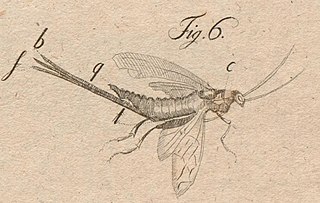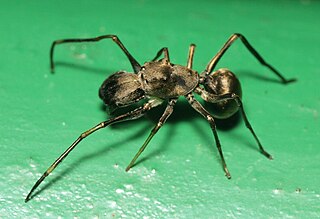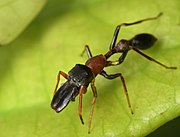
Myrmarachne is a genus of ant-mimicking jumping spiders that was first described by W. S. MacLeay in 1839. They are commonly called antmimicking spiders, but they are not the only spiders that have this attribute. The name is a combination of Ancient Greek μύρμηξ, meaning "ant", and ἀράχνη, meaning "spider".
Kenneth Hervey MacLeay is a former English-born Australian cricketer.
Panachraesta is a monotypic genus of Sri Lankan jumping spiders containing the single species, Panachraesta paludosa. It was first described by Eugène Louis Simon in 1900, and is only found in Sri Lanka. Until 2016, it was a synonym of Myrmarachne.

Salticus is a genus of the family Salticidae. Salticus is the type genus for the family Salticidae.

Deinopis, also known as net-casting spiders, gladiator spiders and ogre-faced spiders, is a genus of net-casting spiders that was first described by W. S. MacLeay in 1839. Its distribution is widely tropical and subtropical. They catch their prey using a specially spun "net". The name is derived from the Greek δεινός (deinos), meaning "fearful", and opis, meaning "appearance", referring to their ogre-like faces. The spelling "Dinopis" is also found, but is regarded as an "unjustified emendation".

The Majoidea are a superfamily of crabs which includes the various spider crabs.

George Williams Peckham and Elizabeth Maria Gifford Peckham were a married couple who were early American teachers, taxonomists, ethologists, arachnologists, and entomologists, specializing in animal behavior and in the study of jumping spiders and wasps.
Myrmarachne melanotarsa, the dark-footed ant-spider, is an African jumping spider found around Lake Victoria in Africa. Like other spiders in the genus Myrmarachne, these spiders mimic ants, in this case, ants of the genus Crematogaster. However, they are unusual in that they exhibit some form of social behavior, forming clusters of silk nests on fig and other trees. Hundreds of these spiders, of both sexes and of all ages, can be found in such communal nests, but most nests have between 10 and 50 spiders. The Crematogaster ants which they mimic are often found in the nests with the spiders, along with other species of jumping spider.
M. japonica may refer to:

Chintamoni Kar Bird Sanctuary (CKBS), also known as Kayal-r Bagan, is a bird sanctuary located in West Bengal, India, south of Kolkata. This garden is famous for its wide variety of birds, butterflies, ferns and orchids.

Nops is a genus of medium-sized South American, Central American, and Caribbean spiders in the family Caponiidae, first described by Alexander Macleay in 1839. It has a great richness on the Caribbean islands, and most mainland species are located in high proportion toward the Caribbean coast. It likely has a neotropical distribution, though most species of South America are known only from the coast of Colombia and Venezuela, including the islands of Aruba, Curaçao, Bonaire and Trinidad.
Myrmarachne uniseriata is a species of spider of the genus Myrmarachne. It is native to India and Sri Lanka. In Sri Lanka, the species was found in the Ethagala range of Kurunegala District. The species can easily identified by the reddish orange-coloured carapace and dorsally flat chelicerae of male.
Myrmarachne morningside, is a species of spider of the genus Myrmarachne. It is endemic to Sri Lanka. The species was first found from Eastern part of morningside section of Sinharaja Forest Reserve. The species can easily identified by mostly shiny surfaces on distal parts of prosoma. The species is sometimes confused with Myrmarachne spissa, only can be carefully separated from a disk-shaped tegulum.
Myrmarachne ramunni is a species of spiders of the genus Myrmarachne. It is native to India, Pakistan and Sri Lanka.
Otiothops is a genus of palp-footed spiders that was first described by W. S. MacLeay in 1839.

Xeris is a genus of horntails found in North America and Eurasia. Achille Costa circumscribed the genus in 1894.

Toxeus is a genus of jumping spiders first described by Carl Ludwig Koch in 1846. The genus was synonymized with Myrmarachne by Eugène Simon in 1901, and remained a synonym until revived by Jerzy Prószyński in 2016, when he split up Myrmarachne.











